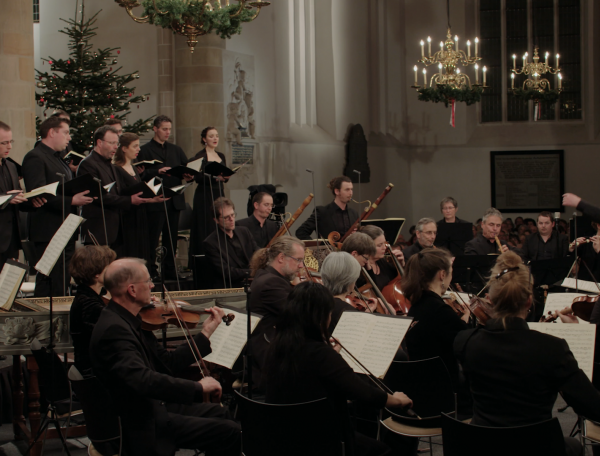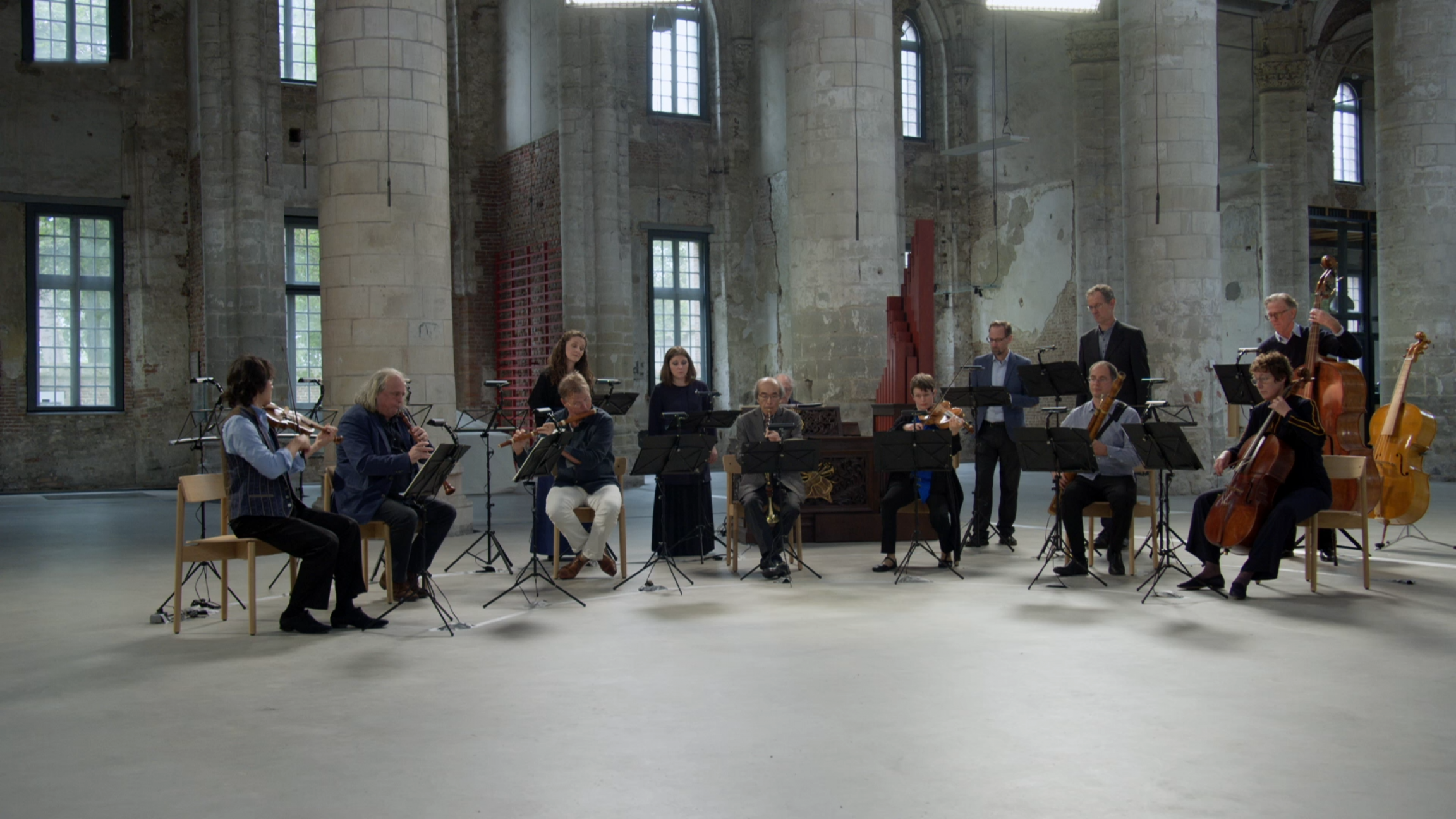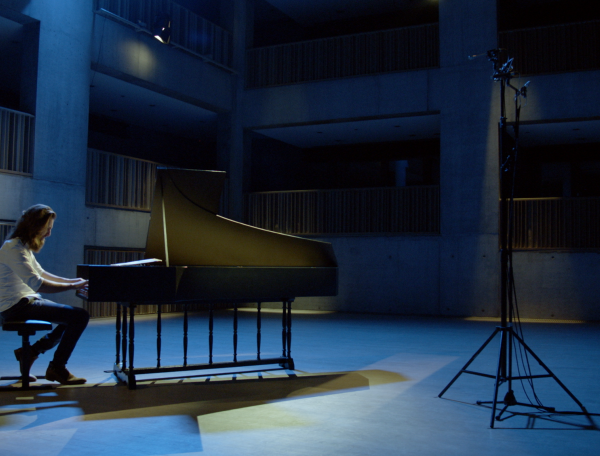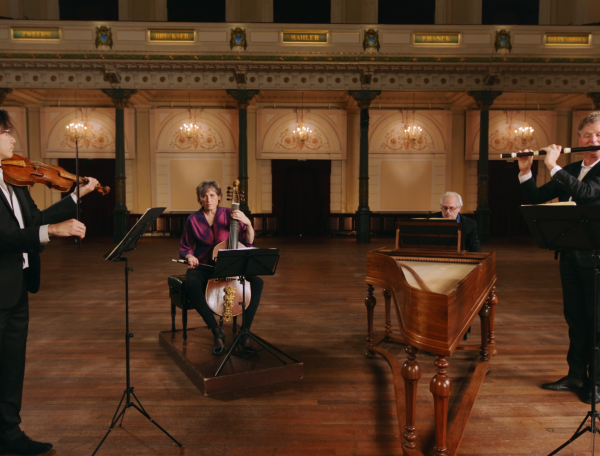

The Art of Fugue
BWV 1080 performed by the Netherlands Bach Society
conducted by Shunske Sato
Grote Kerk Veere
Behind the music
A mountaintop you have to climb at some point
Shunske Sato makes his own instrumentation of Kunst der Fuge
Bach’s Kunst der Fuge (Art of Fugue) is shrouded in mystery. We don’t know whether Bach intended the music as material for practice or performance. The order of the 18 sections is unclear as well and we don’t know whether the piece was ever completed.
Bach already made the first drafts of Kunst der Fuge around 1736. In the latter years of his life, he worked a lot on bigger collections and tinkered with several previously composed works, like the Mass in B minor. From his later scores, it is clear that his eyesight was deteriorating, as his handwriting worsened and became less legible. After his rather sudden death, his work table would probably have been piled with music at all sorts of stages of development, not necessarily all neatly ordered or collected per work.
This was anyway the case with Kunst der Fuge. An edition was being prepared for publication by a printer in Leipzig, who already had a copy of part of the material, but was waiting for another part. In this 1751 edition, you can clearly see it was a struggle to put the material in order. Apparently, the publishers were missing a page of the last big fugue. In the second edition from 1752, the comments state that Bach could not complete the piece, as he died while working on it. Later on, Bach’s son Carl Philipp also wrote something similar. So Kunst der Fuge went out into the world as ‘Bach’s last work’.
For some time now, there have been doubts about this mythical epithet. One of today’s best-known Bach researchers, Christoph Wolff, makes a very convincing case for conferring the ‘last work’ honour on another of Bach’s pieces (the Mass in B minor). He also suspects that Kunst der Fuge was not incomplete. He is convinced that there must have been at least one draft of the final fugue, which was somehow lost after Bach’s death. A fugue like this is actually a sort of puzzle, which means it is still possible to complete the piece and perform it, despite the missing page. In our case, we have used a completion by Kees van Houten and Leo van Doeselaar.
instrumentation
Shunske Sato made his own instrumentation for the Netherlands Bach Society. “I wanted to bring out the many colours of the work and of my ensemble. Every fugue has its own character. On the basis of the rhythm, time and chromatic lines, etc., you can determine which instrument is most suitable. I’ve studied each part very carefully, in order to decide which instruments are best to use. I wanted the whole Netherlands Bach Society to be heard, so the singers are taking part as well. They sing without words, to vowel sounds. When you introduce singers to the Art of Fugue, you can hardly ignore the example of the Swingle Singers. The sung Contrapunctus 9 is intended as a tribute to their great recording."
structure and order
Looking at the names of the various sections of Kunst der Fuge, at first sight it might be difficult to make head or tail of it all. Kunst der Fuge literally means something like: a work of art in the field of the fugue; a form of composition with two or more voices, whereby one part enters and then the same melody is repeated as strictly as possible by the other part(s). This explains the names of the sections: contrapunctus or counterpoint: a melody that is combined with another melody, and canon: a melody that enters into dialogue with itself, or fugue.
In this performance, the various sections have been ordered by complexity. It becomes increasingly complicated. We start with simple counterpoint – combining a melody with exactly the same melody, like identical twins. This is followed by double counterpoint, which combines not one but two different melodies. After that, we get ‘inverted’ counterpoint: twice two pieces that belong together, whereby the melody of one piece is turned upside down in the other – literally inverted. Then come various canons, in which the melody is combined with itself at different pitches (with an interval of 8 notes, the octave, an interval of 12 notes, the tenth or augmented (per augmentationem) and in contrary motion (in contrario motu)). And finally, there is a fuga a 3 soggetti, with three different themes (melodies) that are combined with the ‘basic’ Kunst der Fuge melody. The instrumentation goes from simple to complex as well. As the pieces become more complicated, Shunske Sato also uses instrument combinations you would not necessarily expect.
chorale
In between each of the blocks of increasing complexity, there is a verse from the chorale Wenn wir im höchsten Nöten sein, BWV 432. An extensive organ arrangement of this chorale was added by Carl Philipp Emmanuel Bach to the first edition of Kunst der Fuge, to compensate for the last incomplete fugue.
staging
For this recording, we travelled to Veere (Zeeland). The director Folkert Uhde took inspiration from the space and the light in the Grote Kerk. Folkert Uhde says, “When you stage a work like this and work with light, something happens; something different to when you just hear the music. For example, if you use light as if it were daylight – like in this recording – and have it move from left to right during the concert, it has an influence on your perception of time. The position of the sun changes very slowly throughout the day and you only notice the difference after a while. Only during the course of the piece do you realise that the position of the light has changed, because it has happened so naturally. And if a spotlight is trained on a musician, you anyway listen differently. You imagine you can hear him or her better. So you can play with a great many factors that affect the listening experience and turn such a complex work into a true experience.”
- BWV
- 1080
- Title
- Die Kunst der Fuge
- Genre
- miscellaneous
- Year
- ca. 1736-1750
- City
- Leipzig
- Special notes
- It is not clear for which instrument(s) Bach wrote the piece. There is one version in Bach’s own handwriting and one printed version from 1751/1752. The piece is incomplete or unfinished.
Extra videos
Vocal texts
Original
Wenn wir in höchsten Nöten sein
Und wissen nicht, wo aus noch ein,
Und finden weder Hilf noch Rat,
Ob wir gleich sorgen früh und spat,
So ist dies unser Trost allein,
Dass wir zusammen insgemein
Dich anrufen, o treuer Gott,
Um Rettung aus der Angst und Not
Und heben unser Aug‘ und Herz
Zu dir in wahrer Reu und Schmerz
Und flehen um Begnadigung
Und aller Strafen Linderung,
Drum kommen wir, o Herre Gott,
Und klagen dir all unsre Not,
Weil wir jetzt stehn verlassen gar
In großer Trübsal und Gefahr.
Sieh nicht an unsre Sünde groß,
Sprich uns davon aus Gnaden los
Steh uns in unserm Elend bei,
Mach uns von allen Plagen frei,
Auf dass von Herzen können wir
Nachmals mit Freuden danken dir,
Gehorsam sein nach deinem Wort,
Dich allzeit preisen hier und dort.
Translation
When we are in profound distress,
And lose our way in helplessness,
Without advice to guide our way,
Although we worry night and day,
Our only comfort in such times,
Is that together we may come
And cry to you, our faithful God,
To save us from our worries’ load.
To you we lift our hearts and eyes
In true repentance and in pain,
To plea for pardon; God, relent,
Give us relief from punishment.
And so we come before you, God,
And cry to you in our deep need,
We feel abandoned in our fear
With grief and dangers always near.
Forgive our sin and misery,
And in your grace, Lord, set us free,
all our anguish with us stand,
And free us with your mighty hand,
So that we can give heartfelt praise
And our thanksgiving to you raise,
In full obedience to your Word
We thank you now and evermore.
translation © Ruth van Baak Griffioen, 2020
Credits
-
- Release date
- 15 September 2022
-
- Recording date
- 30 September and 1 October 2021
-
- Location
- Grote Kerk Veere
-
- Violin and direction
- Shunske Sato
-
- Soprano
- Lauren Armishaw
-
- Alto
- Sofia Gvirts
-
- Tenor
- Immo Schröder
-
- Bass
- Donald Bentvelsen
-
- Viola
- Femke Huizinga
-
- Cello
- Viola de Hoog
-
- Double bass and violone
- Robert Franenberg
-
- Viola da gamba
- Mieneke van der Velden, Ricardo Rodriguez Miranda, Anna Lachegyi, Alex Baker
-
- Traverso
- Marten Root
-
- Oboe
- Marcel Ponseele, Taka Kitazato
-
- Bassoon
- Benny Aghassi
-
- Trombone
- Simen Van Mechelen, Joost Swinkels
-
- Cornetto
- Étienne Asselin
-
- Organ
- Leo van Doeselaar
-
- Stage director
- Folkert Uhde
-
- Music recording
- Guido Tichelman, Lilita Dunska, Pim van der Lee
-
- Music edit and mix
- Guido Tichelman
-
- Camera
- Onno van Ameijde, Carrien Dijkstra, Jasper Verkaart
-
- Lights
- Jörg Bittner, Ernst-Jan Thieme, Bart Verbeet
-
- Best boy
- Patrick Galvin
-
- Video editing
- Robin van Erven Dorens
-
- Assistant music recording
- Marloes Biermans
-
- Producer concert
- Imke Deters
-
- Producer film
- Jessie Verbrugh
Discover
Help us to complete All of Bach
There are still many recordings to be made before the whole of Bach’s oeuvre is online. And we can’t complete the task without the financial support of our patrons. Please help us to complete the musical heritage of Bach, by supporting us with a donation!

